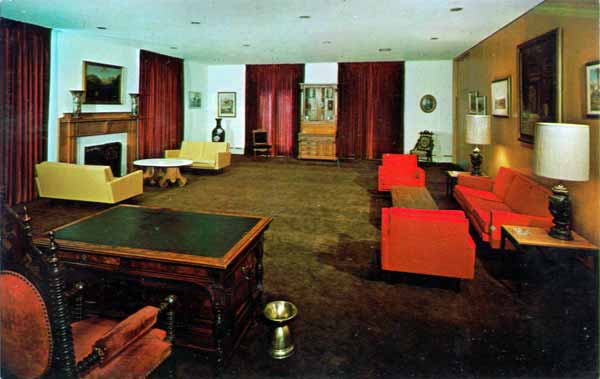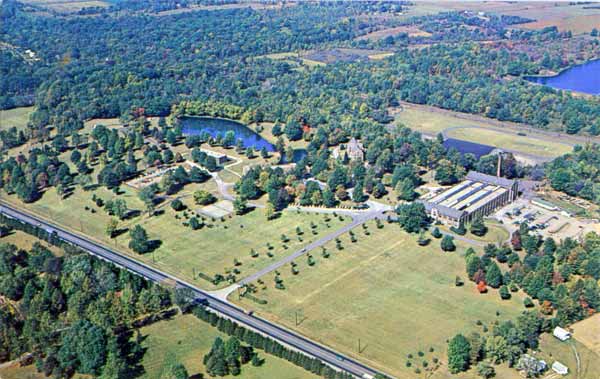
Terre Haute Postcards - Rose Polytechnic Institute (5)
More postcards from my collection...

Rose Polytechnic Institute, Terre Haute, Ind.
This postcard, stamped in Terre Haute on October 15th, 1969, has the following printed text...
Alumni Room
Hulman Memorial Student Union
Rose Polytechnic Institute
Terre Haute, Indiana
This section of the Union, the Chauncey Rose Wing,
houses items formerly belonging to Chauncey Rose,
founder of the Institute.
RP-8A
28895-C
Pub. by Bob Wyer Photo Cards, Delhi, N. Y.
Ektachrome by Bob Wyer, Delhi, New York
All Rights Reserved

Rose Polytechnic Institute, Terre Haute, Ind.
This unused postcard has the following printed text...
Rose Polytechnic Institute
Terre Haute, Indiana
This is a privately endowed college for men. It
offers Bachelor of Science degrees in Chemical
Civil, Electrical and Mechanical Engineering and
in Chemistry. Over 500 students attend this college.
P56358
Pub. by Wabash Valley News Agency Inc., Terre Haute, Ind.
Plastichrome by Colorpicture Publishers, Inc., Boston 30, Mass., U.S.A.
Rose Polytechnic is another of those Terre Haute educational establishments that has changed buildings and locations over the years. Chauncey Rose (1794 - 1877) formed a corporation on September 10, 1874 known as the Terre Haute School of Industrial Science, which in 1875 and against his wishes, was renamed Rose Polytechnic Institute and later still, in 1971, became the Rose-Hulman Institute of Technology. The cornerstone of the original 4-strorey building was laid on September 11th, 1875 at Thirteenth and Locust Streets. McCormick and Sweeney built the 46 room structure which opened in March 1883 and produced its first graduates in 1885. There were only 25 students the first year and they paid $75 tuition per year; $25 for "incidentals" and $10 for books.
By 1910, a newer building was needed and in 1922, Rose Polytechnic Institute moved to it's current location just east of the city on 123 acres of land donated by the Hulman family. The newer building is the two-storey structure pictured above. The old building became Gerstmeyer Technical High School but has now been demolished.
Baur -Sames - Bogart Hall, more commonly known as BSB Hall, was built in 1956. It is an L-shaped hall of residence with room for 144 students on three stories, mostly freshmen. The offices and studios of the campus radio station occupy much of BSB's basement. On December 31st, 1970 the Rose Polytechnic Institute became the Rose-Hulman Institute of Technology.
The following text comes from the New York published Frank Leslie's Illustrated Newspaper dated March 17th, 1883...
This institution, one of the most prominent and useful in the thriving City of Terra Haute, is the outgrowth of the Terra Haute School of Industrial Science, which was grounded in September, 1874, having as its object the intellectual and practical education of young men in the principles of the mechanical arts as applied to the trades and avocations of life. Three months later, Mr. Chauncy Rose donated to the management a tract of ten acres of land as a site for school-buildings, with $186,000 of securities, and plans having been procured and approved, in the following May work was commenced on the academic building - the name of the school having meanwhile been changed to Rose Polytechnic Institute, in recognition of the liberal endowment made by that gentleman...
An examination for admission of a class from twenty to twenty-five pupils in mechanical engineering was held on the 6th instant. On the day following the inauguration ceremonies were held, when address were delivered by Governor Porter...
The main building is constructed of pressed red brick, with facings of stone or of Milwaukee brick, and is five stories in height, including basement and attic. It has an extreme length of 200 feet, a depth of 80 feet in the central transept, and of 64 feet in the two terminal transepts. On the three main floors it contains six large halls, adapted to museum, laboratory, library, and studio purposes, with twenty-three professors' rooms, two spacious reception-rooms, toilet, hat and cloak rooms, fitted with every convenience, and a handsome chapel, 76 feet by 42 feet in dimensions. It is heated by steam, with direct radiation, and can be made comfortable in the severest weather with a pressure of but twenty pounds. The water supply is connected with the City Waterworks, and has large tanks on the roof to meet an emergency of fire.
Frank Leslie's Illustrated Newspaper commenced publication in 1855 and was also known as Leslie's Weekly. It ceased publication in 1922.
William Albert Noyes became Chemistry Professor at Rose Polytechnic Institute in 1886. Professor Noyes' salary was $1,850 per year, later raised to $2,250, and his starting salary was the highest paid to any professor of chemistry west of the Alleghenies at that time. Professor Noyes was the Chemistry Department at Rose Polytechnic Institute, and for many years he taught all of the courses of the chemistry curriculum. The seniors in the curriculum were required to present theses based on original research. Several of these were published in the American Chemical Journal, and Noyes' early scientific reputation was based on this work. Some students from those days, particularly George W. Morey, later attained eminence. Noyes left Rose Polytechnic in 1903.
A more detailed history of the Rose-Hulman Institute of Technology can be found on the Institutes website and on Wikipedia.
This page created 20th November 2009, last modified 11th January 2010